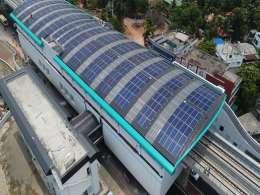The chief executive officer of a large Indian utility was recently quoted by a business daily as saying, “Investment won’t come just because someone’s talking about it.â€
Nothing could be more reflective of this than the wind industry in India. In FY16, it recorded one of the best years ever sans any centralised procurement, plug and play solutions that do away with much of permitting, land, right of way, power evacuation challenges and additional assurances on bankability of projects or viability gap funding to spur offtake. In short, a bumper year of achieving 3,460 megawatt (MW) capacity and expectations of around 4,500MW next year, achieving all that the national renewable energy programme aspires for—private-sector led, domestic manufacturing and competitive tariff.
Back in April 2015, the outlook was sombre and not without a reason. While a key wind state of Maharashtra had a power purchase agreement (PPA) backlog, Tamil Nadu and Rajasthan had payment arrears and the promising Andhra Pradesh had just went through state bifurcation. A closer look is hence warranted at the 3,460MW split to not only understand what went right, but also to learn lessons, if any, to sustain this momentum.
The most striking aspect of wind turbine generator addition during FY16 is not the volume, but the state. At 1,292MW, Madhya Pradesh is the first state to achieve that mark in a financial year and that too in what’s traditionally been considered a low-wind zone. Sceptics may be quick to point out the high tariff, but for a state to increase installed base by 2.5 times in a single year is no mean achievement. That Rajasthan comes second, and together the two states accounting for around 57% of the national capacity, lends a different perspective to the issue of payment security from distribution companies and how investors are pricing in the risk. The underlying message, if any, is one of reasonable certainty of the development process culminating in a signed PPA and no hidden surprises that cannot be modelled in a risk-return frame.
The original equipment manufacturer (OEM) landscape is perhaps the most heartening aspect of the achievement with domestic home-grown companies taking four of the top five spots and contributing nearly two-third of the capacity added. It would only be fair to say that Suzlon Energy Ltd is synonymous with renewables just as Infosys is to information technology in the country and the company’s return reinforces that renewables is the future. With Inox Wind Ltd a close third, vendors, ancillaries and contractors which employ a far larger number of people than the IPPs would heave a sigh of relief, temporary as it may be if this momentum is not sustained.
Forecasting has always been a hazardous business but results are manifesting in increased activity on the ground. While the trend in the recent past was wind independent power producers (IPPs) moving towards solar, the last few months saw the likes of IL&FS-Orix and EDF-Sitac move on the wind IPP. Supplemented by OEM’s such as Gamesa and GE, among others, launching bigger and better machines suited to India conditions, the return of Vestas to India and likely newer OEM entrants such as Senvion and Envision, the market outlook is buoyant. While industry predictions of 4,000-4,500MW would be an outcome for time to vet, the ground realities indicate that the India wind story is here to stay.
What effectively could derail the storytelling are events, both policy and regulatory, that either lend uncertainty to the PPA process such as in Maharashtra or tariff resets as in Madhya Pradesh. The merits of the individual case apart idling of assets for want of PPA is simply a depreciation of capital and has an adverse impact on closing new investments on account of the uncertainty of the long-term annuity. Similarly, as an investor it’s unsettling when regulatory orders issued for a similar wind regime could have a tariff variation of nearly Re1 per kilowatt hour when they are issued within a fortnight for the same financial year.
In essence, the wind story during FY16 offers simple lessons for stakeholders—for developers and investors to be cognizant of the control period and inherent variation associated with timing a control cycle, for policy to offer a certainty in the public private partnership process sans surprises at the time of or closer to commissioning, and that regulations must be consistent lest revisions and amendments become more of a norm than an aberration. Wind epitomizes all that the new dispensation stands for, be it jobs, foreign direct investment or domestic manufacturing and a little bit of consistency is all it would take to help the wind industry command its rightful place under the sun.
Rupesh Agarwal is partner, BDO India LLP, a tax and advisory firm.
Like this Column? Sign up for our daily newsletter to get our top reports.





